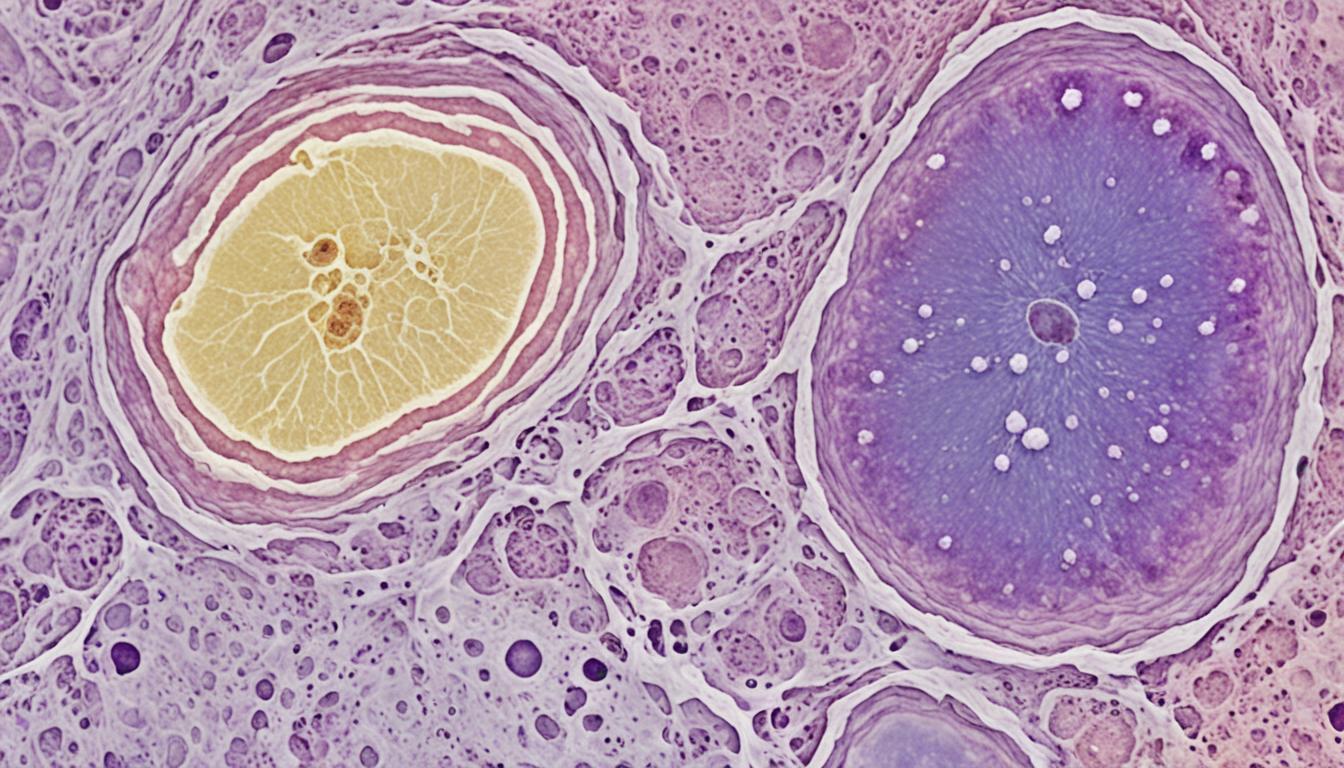Ductal carcinoma in situ (DCIS) is the earliest breast cancer stage. It stays within the milk duct of the breast. DCIS is often called stage 0 cancer or non-invasive breast cancer. It doesn’t usually spread outside the ducts, but can lead to invasive breast cancer.
Doctors find DCIS usually through mammograms. These can see if there are unusual changes in breast tissue. A biopsy is then used to check for cancer cells. Treatment includes lumpectomy, lumpectomy and radiation, mastectomy, or endocrine therapy. Yet, stem cell therapy is not a common treatment for DCIS.
Key Takeaways:
- DCIS is the earliest form of breast cancer and is confined within the milk ducts.
- It is also known as stage 0 cancer, non-invasive breast cancer, or pre-cancer.
- Diagnosis involves mammograms and confirmation through a biopsy.
- Treatment options include lumpectomy, mastectomy, radiation therapy, and endocrine therapy.
- Stem cell therapy is not a commonly used treatment for DCIS.
Diagnosis and Staging of DCIS
Diagnosing Ductal Carcinoma in Situ (DCIS) means running several tests. These tests show how much the disease has spread. The main test is a mammogram. It can detect unusual changes in the breast.
When the mammogram finds something strange, more tests are done. Such as more detailed mammograms or ultrasound. These tests look closer to find out the size and type of the issue.
Confirming cancer cells need a biopsy. The main type for DCIS is a core needle biopsy. In this, a small part of the tissue is taken for testing.
DCIS is at stage 0, not spreading outside the milk ducts. Catching it early means better treatment and outcome. So, regular mammograms for those at risk are very important.
The Importance of Mammograms in DCIS Diagnosis
Mammograms are key in finding DCIS. They are advised for all women over 40. Or earlier if there are risks like family history.
Mammograms use two plates to take images. It might be a little uncomfortable but it’s over quickly. And most people do fine with it.
Early mammograms can catch DCIS before it turns into a worse cancer. This means treatment can be less hard. And it leads to better chances of getting well.
The Role of Biopsy in Confirming DCIS
A biopsy confirms if DCIS is in the breast. A common one is the core needle biopsy. It takes a small piece of tissue for testing.
The piece is then checked in a lab. Doctors look at it under a microscope. This gives clear details on how to treat the DCIS.
Now, let’s look at the treatments for DCIS. We want to make sure those diagnosed get the best care.
Treatment Options for DCIS
When you have DCIS, various treatment options are available. These are tailored to your unique needs and choices.
Lumpectomy: This surgery keeps most of your breast. It removes the cancer area and a bit of healthy tissue around it. It’s a good choice for those wanting to keep their breast.
Radiation Therapy: After a lumpectomy, radiation therapy might be needed. It targets any cancer cells left in the breast. This can really improve long-term results for DCIS patients.
Mastectomy: If DCIS covers a big area or looks concerning, a mastectomy might be advised. It removes the entire breast tissue. Although more extensive, it stops any recurrence and ensures all cancer is gone.
Endocrine Therapy: For DCIS that’s fueled by estrogen, doctors might suggest endocrine therapy. This treatment uses drugs that stop estrogen from feeding the cancer. It cuts the risk of more cancer or worsening of the disease.
All DCIS treatment options lead to high survival rates. Doctors pick based on what’s best for each patient, considering their health and wants.
Benefits and Considerations of Different Treatment Options
Every DCIS treatment comes with its own pros and cons:
- Lumpectomy saves your breast and has a quick recovery. Yet, radiation therapy is often needed after to lower the chance of cancer coming back.
- Radiation after surgery cuts the risk of cancer return. But, it can make your skin change and make you tired for a while.
- Mastectomy prevents local cancer return. It gives peace to those worried about more cancer. Yet, it removes the entire breast which might affect self-image.
- Endocrine therapy is a non-surgical choice for cancer that feeds on estrogen. It can reduce the risk of cancer returning. But, it might bring some side effects like hot flashes and joint pain.
If you’re diagnosed with DCIS, talking openly with your doctors is crucial. Understand what each treatment offers and its possible downsides.
Remember, the best treatment choice depends on many factors. These include how far the cancer has spread, your overall health, and what you prefer. A specialist in breast cancer can help you make the right treatment decision for you.
Prognosis and Future Outlook for DCIS
The outlook for Ductal Carcinoma in Situ (DCIS) is often very good with proper treatment. Early discovery and treatment lower the chance of DCIS becoming invasive. But, certain factors can change a patient’s outcome.
If someone is younger, has a bigger tumor, or has high-grade DCIS, the risks go up. More attention and possibly stronger treatments may be needed. Scientists are looking for better ways to tell apart low-risk and high-risk DCIS. They want to customize treatment for better results.
Regular check-ups and tests are key to keeping an eye on any changes or risks. These visits help doctors see how well the treatment is working and if there are new issues. It’s important to talk openly with your healthcare team. This helps you stay on top of your care and decisions.

